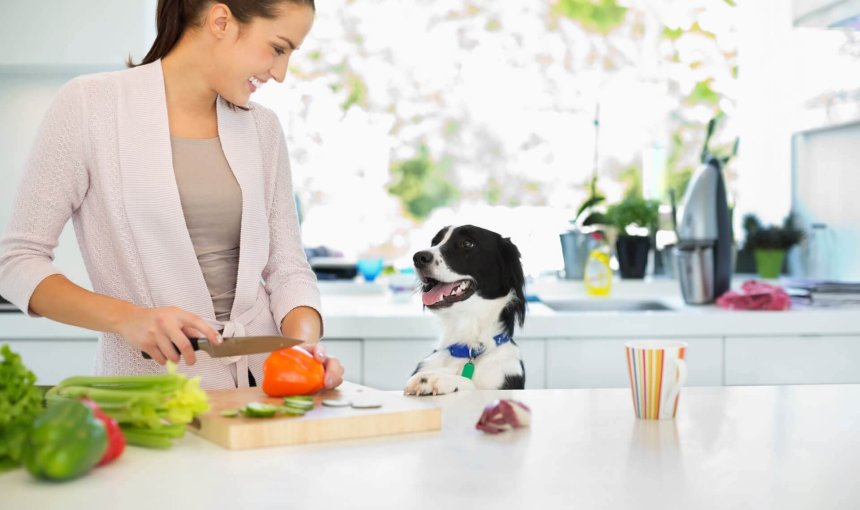Can Dogs Eat Celery?
You may love or hate celery - but can your dog eat it too? Find out if celery is safe for dogs and how to best feed this healthy vegetable to your furry friend in this post.

We know we shouldn’t, but most of us do it anyway – we give our dogs food from the dinner table. It’s just so hard to resist those pleading puppy eyes gazing up as we sit down for a meal! Or maybe you’re a healthy snacker and love enjoying fresh raw celery. But can dogs eat celery too? Find out if celery is on the menu of safe foods you can share with your dog in this post.

Always know your buddy is healthy & safe
Read moreCan dogs safely consume human foods?
Some foods eaten by humans can be poisonous to dogs, so veterinarians recommend that we feed dogs only commercial or homemade dog food. These diets contain all the essential vitamins and minerals needed for optimum health. Feeding dogs table scraps instead of a nutritionally complete dog food not only exposes them to potential toxic human foods, but a food-scrap diet may not meet your dog’s daily nutritional requirements.
However, there are some humans foods that are safe for dogs to consume, including many fresh vegetables and some fruits.
Can dogs eat celery?
Yes, dogs can eat celery! Many (but not all) vegetables are safe and healthy for dogs to eat in small amounts. Celery is at the top of the list of healthy dog treats.
Celery makes a good dog treat because it is available in most grocery stores, and it is relatively inexpensive. And if you purchase organic celery, you will avoid potential toxins that may be present in the leaves of non-organic celery.
Veterinarians recommend that vegetables, including celery, should make up no more than 25% of your dog’s daily food intake. If you’re unsure if celery is appropriate for your dog, or if your dog has food sensitivities or a medical condition, talk to your veterinarian before offering it as a treat.
Health benefits of celery for dogs
Celery can be beneficial for your dog’s health when offered in moderation. Celery provides fiber, vitamins, minerals, and is low in calories. Because celery has a high water content, it can also help to keep your pup hydrated. As a bonus, most dogs seem to enjoy eating celery because it has a satisfying crunch. Not to mention, celery can even help dogs to have cleaner teeth and fresher breath!
Celery: a low-calorie treat
Commercial dog treats can be high in calories and contain fillers or chemical preservatives. Celery, on the other hand, is free of these substances – especially if you choose organic celery.
Have a stash of celery ready for your dog by cutting celery sticks into bite-sized chunks. Place the celery chunks in a plastic container, cover the celery with cold water, and put the covered container in the refrigerator. These pre-cut celery chunks will be ready to grab as a training reward or a refreshing snack after a long walk.
You probably didn’t know that celery is also a breath freshener! Because it is crunchy and has a high water content, celery stimulates the production of saliva in your dog’s mouth. The saliva helps to wash away bacteria and plaque that can cause stinky dog breath.
For overweight or obese dogs, celery is an excellent choice for a treat. It is lower in calories than commercial dog treats, so it could help with weight loss. Celery is also low in cholesterol and fat, and contains these vitamins:
- Vitamin A: Important for maintaining healthy eyesight, Vitamin A is also beneficial for your dog’s skin, muscles, and nervous system.
- Vitamin K: Proper blood clotting is supported by Vitamin K, as well as strong bones.
- Vitamin B: This group of vitamins includes folate and thiamine, which help with digestion and energy release.
Aside from vitamins, celery also contains important minerals such as potassium, calcium, zinc, iron, and magnesium. All of these nutrients are part of a healthy diet for your dog.
Can dogs eat broccoli and other vegetables? Yes, other fresh veggies including broccoli can be healthy for your dog to consume in limited amounts.
Potential risks of a dog eating celery
Choking hazard
Feeding dogs an entire celery stick is not recommended. This veggie is difficult to chew due to its fibrous consistency. If your dog is small, or tends to scarf down their food without chewing, large celery sticks could be a choking hazard. It’s better to cut the celery into bite-sized chunks that your dog can munch on without worrying about choking.
High sodium
Celery does contain relatively high amounts of sodium, so it’s important to give this veggie to your pup in small amounts. Too much sodium in a dog’s diet can affect kidney function and elevate blood pressure.
Upset stomach
Because of its high fiber content, eating too much celery can cause digestive issues in your dog, including diarrhea, gas, or vomiting. It’s best to offer only a few bites of celery to your dog to be on the safe side.

Get health alerts for your dog
Our pups can’t always tell us if something’s wrong. But if their tracker detects unusual changes in their routine, you’ll get an alert, helping you catch potential issues early.
Pesticides
Celery leaves can harbor pesticides, so you may want to avoid offering the leaves to your dog unless you wash them thoroughly first. Or choose organic celery, which is grown without harmful chemicals.
How much celery can I give my dog?
Your dog may love eating celery as a snack, treat, or as part of their meal. But just because your pup likes celery doesn’t mean they can eat an unlimited amount. Moderation is the key when introducing any new food to your dog.
The amount of celery you give to your pup depends on their size and weight. Try offering just a few bite-sized pieces to your small dog. Larger dogs can eat a small handful of chopped celery. Just keep an eye on your pup for signs of digestive issues after feeding a new food item such as celery.
Can dogs eat celery cooked or raw?
Dogs can safely eat both raw celery and cooked celery, so feeding dogs celery is OK. If your dog has trouble chewing raw celery or seems to swallow it in one gulp, try cooking the celery first. Cooked celery is easier for your dog to digest and to chew, so it is less of a choking hazard.
To cook raw celery, cut it up and drop in boiling water for a few minutes until it softens up a bit. Do not add salt to the cooking water – celery already contains sodium, so there’s no need to add any. Large amounts of sodium can be harmful to your pup.
Some pet parents add small amounts of chopped veggies like raw or cooked celery to their pup’s daily meals.
For an extra-special treat for you and your pup, try smearing peanut butter on raw celery. If you like ants on a log (celery topped with peanut butter and raisins), skip the raisins when making this treat for your pup. Raisins and grapes are among the foods that are toxic to dogs, along with peanut butter that contains xylitol as a sweetener.
How can I tell if a dog has eaten too much celery?
Feeding celery to your dog is good, but celery should supplement, not replace, their main diet of commercial or homemade dog food. Over time, if your dog eats too many treats and their diet lacks essential nutrients, you may see changes to their weight, skin, hair, or body functions.
If you feed celery as a treat and your dog consumes too much in one sitting, they may experience loose stools, diarrhea, or upset stomach later in the day. Keep celery servings small so this healthy veggie remain a special, once-in-a-while treat.
Celery can be part of a healthy diet for your dog
Celery can be part of your pup’s daily health regimen in small amounts, because it offers many nutritional benefits. A healthy diet is important for your dog’s well-being, along with daily walks, play sessions, and mentally-stimulating activities. By including fresh, healthy food and plenty of exercise, you and your pup can enjoy many adventures together.
P.S. While you’re here, check out:



